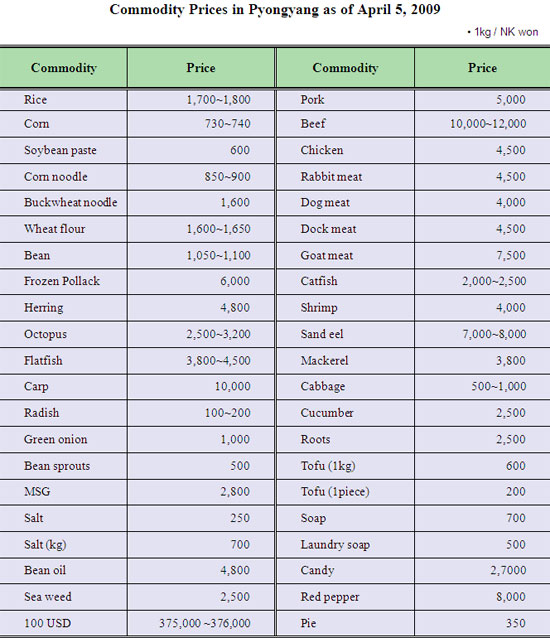Institute for Far Eastern Studies (IFES)
NK Brief No.09-12-16-1
12/16/2009
In accordance with the recent currency reform in North Korea, new state-controlled prices were officially announced on December 9. South Korean NGO ‘Good Friends’ announced on December 13th that rice is now selling for 23 won per Kg, corn at 8 won per Kg, flour at 22 won per Kg, pork at 45 won per Kg and ‘matnaegi’, a common flavor-enhancing food additive, is selling for 45 won per bag. Other prices were also listed per kilogram, including crushed maize at 12 won, corn noodles for 10 won, soybeans from 9-13 won, soybean oil for 50 won, radishes at 5 won, artificial meat for 15 won, and cowpeas for 10 won.
On December 4, the Choson Sinbo, a newspaper printed by the pro-North Korean General Association of Korean Residents in Japan (Jochongryeon), reported that North Korean authorities were planning to lower prices to the same level as was seen when the July 1, 2002 Economic Management Reform Measure was enacted.
At the end of November, prior to the currency reform, rice was selling for 1,850 won in Hamheung, 2,000 won in Cheongjin, and 1,700 won in Pyongyang and Sariwon.
In the markets of these four major cities, corn averaged 737.5 won/Kg, flour was sold for 1,687 won/Kg, and pork was 5,450 won/Kg. Pork is the only item now being sold more cheaply, while the price of all other goods went up with the currency reform.
A source inside North Korea has reported that most market traders are not following government pricing guidelines, however, and that the majority of goods are being sold at even higher prices than Pyongyang has set. In the market in Cheongjin, North Hamgyeong Province, rice was being sold for 50 won/Kg, and corn went for 18 won/Kg, more than double government prices. These high prices appear to reflect supply shortages and hoarding.
After the currency reform was announced, North Korean miners received raises, from a basic monthly wage of 6,000 won to the equivalent of 8,000 (pre-reform) won. Miners in North Hamgyeong Province can now put enough food on the table without needing second jobs. On December 4, the Choson Sinbo also reported that the government has guaranteed that living expenses distributed by factories will be distributed in the new currency.

